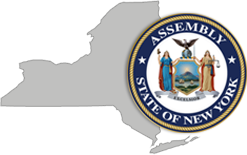A00127 Summary:
| BILL NO | A00127 |
| SAME AS | SAME AS S00159 |
| SPONSOR | Weprin |
| COSPNSR | Walker, Hunter, Cruz, Mamdani, Gonzalez-Rojas, Mitaynes, Kelles, Burdick, Anderson, Meeks, Septimo, Davila, Zinerman, Ramos, Gallagher, Clark, Peoples-Stokes, Bichotte Hermelyn, Sayegh, Lupardo, Jacobson, Glick, Jackson, Hyndman, Steck, Paulin, Gibbs, Fall, Bronson, Tapia, Cunningham, Lucas, De Los Santos, Shrestha, Raga, Seawright, Levenberg, Shimsky, Bores, Kim, Hevesi, Cook, Reyes, Rosenthal, Taylor, Forrest, Carroll R, Epstein, Simon, Alvarez, Lavine, Simone, Zaccaro, Dilan, Chandler-Waterman, Lee, Barrett, Benedetto, Dais, Rajkumar, Stirpe, Solages, Valdez, Romero, Hooks, Burroughs, Wright, Wieder, Torres |
| MLTSPNSR | |
| Amd §259-i, Exec L | |
| Provides for findings of the state board of parole necessary for discretionary release of incarcerated individuals on parole. | |
A00127 Memo:
Go to topNEW YORK STATE ASSEMBLY
MEMORANDUM IN SUPPORT OF LEGISLATION
submitted in accordance with Assembly Rule III, Sec 1(f)
PURPOSE: Provides that the Board of Parole shall release inmates upon completion of their minimum terms of incarceration unless doing so presents an unreasonable public safety risk or the inmate is unlikely to live with- out violating the law. SUMMARY OF PROVISIONS: Section 1 amends Executive Law § 259-i (2)(c)(A). Section 2 provides an effective date. JUSTIFICATION: When making a decision about whether to release an inmate to community supervision, the Board of Parole is currently required to take into account the inmate's likelihood of committing future crimes upon release and to determine whether or not an inmate's release will deprecate the seriousness of the crime. In practice, the Board does not often release an inmate on his or her first. appearance if the underlying crime was violent, even it if it took place more that 25 years prior to the board appearance and the inmate has a low risk of reoffending. Current law also makes the board susceptible to political pressure to deny parole to inmates with high profile crimes even if they are thoroughly rehabili- tated with excellent prison records because such a release could be considered by advocacy groups to "deprecate the seriousness of his crime." In 2015, only 17% of inmates were released upon their first board appearances, and only 20% on subsequent appearances. The Board's failure to grant parole to low risk inmates results in expensive, prolonged, unnecessary incarceration of middle aged and older inmates who have a very low probability of recidivism and who are very expensive to incarcerate because of high medical costs. This bill would require the board to release people to community super- vision when their minimum period of incarceration has been served unless there is a clearly articulated current public safety reason to keep them in prison. On subsequent board appearances, there would be a presumption of release unless the board determines by a preponderance of evidence that an inmate is unlikely to live without violating the law and that his or her release poses an unreasonable public safety risk. PRIOR LEGISLATIVE HISTORY: 05/01/17 referred to correction 06/06/17 reported referred to codes 01/03/18 referred to codes FISCAL IMPLICATIONS: This bill will save the state approximately $60,000 per year for every inmate ,who is released upon the completion of his or her minimum sentence but who would have been kept in prison under current. law. It has no costs associated with it. LOCAL FISCAL IMPLICATIONS: None. EFFECTIVE DATE: Immediately.
